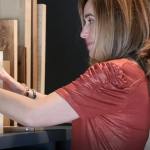Wood is a sustainable building material
Wood is a highly versatile building raw material and the only renewable building material. Wooden structures are generally characterized by a combination of different components that together provide the best possible load capacity, thermal, acoustic and moisture insulation, fire resistance, and long service life.
Increasing the use of wood in construction can make it easier to reduce the use of other construction materials, such as concrete, steel, and brick. These construction materials do not come from renewable raw materials, so they require a large amount of energy for their production and lead to higher carbon dioxide emissions.
The EU’s long-term plan for a competitive low-carbon economy is called the 2050 Roadmap. The key driver of this transition will be energy efficiency. A low carbon economy will have a much greater need for renewable energy sources, energy efficient building materials manufacturing, energy efficient structures and energy efficient modes of transport.
In this context, the construction sector has short and long-term opportunities to reduce carbon dioxide emissions through the choice of materials with low environmental impact and through energy efficient structures. Increasing the use of wood products is part of the solution. At Pallars Fustes we are also dedicated to the restoration of wooden structures.
Production of different building materials
The last two decades have seen the rapid development of wood in architecture as a result of the EU’s shift to function-centered standards in member state building regulations. This now makes it possible to construct larger buildings using wood-based systems.
The manufacture of wood products requires very little external energy, in addition to the energy of its own by-products. 80% of the energy consumed by Swedish sawmills comes from bio fuels from their own production lines, such as bark and shavings, while 20% is electrical energy. The most energy-consuming stage of the process is the drying of boards and planks. This is also the stage that uses most of the electrical energy to run the fans in the dryers.
When manufacturing other building materials, the starting point is always finite raw materials. Both extraction and processing require energy, often in very large amounts from fossil fuels.
Cement manufacturing generates significant carbon emissions, as do steel manufacturing processes. All construction materials produced by these processes therefore have a negative impact on the carbon footprint. This measure of carbon dioxide emissions and other greenhouse gases from a product or activity helps clients to choose the option with the least impact on the environment. The effect of carbon build-up in wood causes the emissions associated with harvesting, transport and processing to be very low compared to the amount of carbon dioxide stored.
Wood can replace other building materials.
Wood can replace other building materials in many structures while providing the same functionality. An example of this is in the Swedish regulations for bridges (Bronorm), where it is encouraged that they can be designed for the same function and useful life as steel and concrete bridges. Such material substitution could bring significant climate benefits, where wood replaces materials whose production requires fossil fuels and causes high carbon emissions. A study has shown that when wood products replace other construction materials in buildings, there is an estimated average substitution factor of 1.6 tons of carbon dioxide per cubic meter of wood material. This means that an industrially produced apartment with a wooden frame adds 16 tons of carbon dioxide. With a higher energy efficiency unit and climate smarter buildings, the production phase and material options will become more important as will the replacement options.
Environmentally efficient life cycle and EcoCycles
All building materials, except wood, have a unique ecological cycle that involves reuse. For wood there are two possible EcoCycles: a shorter cycle that reuses the component and a longer one that reuses the constituent parts of the wood material through nature’s EcoCycle.
We see examples of the shortest green cycle in the construction, distribution, and packaging industry. Windows, doors and wood can be reused, as can pallets, packaging and cable drums. In all cases, there is a process to test the products and find new uses.
Once wood can no longer be reused or its reclaimed material is no longer suitable for use in fiberboard and other laminated materials, it can still be put to use, for example, by generating energy through incineration as a last option. This energy is climate neutral and is, in fact, stored solar energy.
To make optimal use of wood in terms of climate, it must be carried out following a particular order that is seen in the environmental hierarchy for wood (see below). When choosing between different use options, you should always choose the alternative that offers the longest period of use, that is, the one that is higher in the environmental hierarchy. The direct use of cleared forests for energy production is not optimal, although it is naturally still better for the environment than energy from finite fossil fuels. It is important to note that it is never necessary to send wood to the landfill.
Building with wood is good for the climate
To achieve a climate neutral society depends on greater energy efficiency and a wider use of renewable energy sources.
For the construction and real estate sector, this will have an impact on both the production and use phases. On the one hand, for new construction, it is about the choice of materials and having a construction production with low environmental impact and an energy efficient building at the end of it. On the other hand, for existing buildings, the focus will be largely on energy efficiency, as the environmental impact of the construction phase has already occurred.
Looking ahead to the year 2050, it is estimated that approximately 80% of the current stock will be buildings that already exist today. These need to be updated to fit the future, therefore it is not a coincidence that the main focus is on energy efficiency. However, we have chosen to present the case for new construction as this provides a complete picture of the system for future building design.
Historically, the operational phase of a building has represented the highest energy consumption during the lifespan of the building and the production phase has been considered almost negligible. With the arrival of new and increasingly stringent requirements regarding energy use in our buildings and, in an extreme case, zero energy buildings and energy use in the production phase will become increasingly important.
Adapting the choice of materials, designs and production processes to new conditions is a great challenge for the construction sector. Increased use of wood structure based products is an important part of the solution due to the carbon storage and replacement effects of the material.
At Pallars Fustes we are very committed to recycling and sustainability, which is why we believe that the restoration of wooden structures is a key point to give a long life to our constructions.




